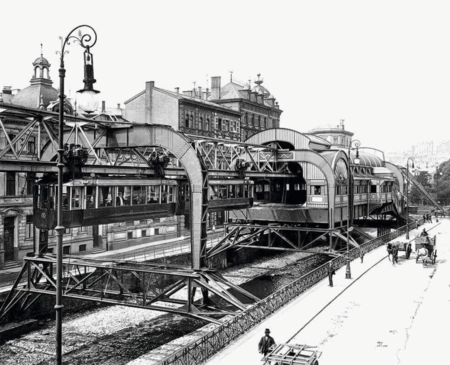Although there are several hanging railways in the world, such as the Chinese Xingguo or the Chiba Urban Monorail from Japannone of them are that old like Wuppertalwhich is located in the German city of the same name. We are facing a means of transportation inaugurated in 1901 which is still in operation. Around 85,000 people use it daily to move between its 20 stops, although it has also become a tourist stop that allows visitors to explore the city from above.
The origin of the project dates back to the 1980s, when the districts of Barmen and Elberfeld agreed on the need to improve the mobility options that their residents had. At first two separate commissions were created to materialize their ideas, although these ended up merging around 1887. They received a wide variety of projects, although one called “System Langen” ended up prevailing. Almost a decade later the contract to develop the suspension railway was formalized.
A train as old as it is impressive
Work began in 1898 with the construction of the first section. This was a very important step because it allowed us to evaluate the performance of two test cars. The idea on paper was fantastic, but it had to be proven that this never-before-seen alternative was reliable enough. The project passed this important stage. The vehicles, for their part, were prototypes that had not been designed to transport people, so they were somewhat different from the production ones that arrived later.
With the help of cranes and scaffolding, the railway took shape. In the early 1900s everything was finally ready for the start of operations. There were 21 main cars and five secondary cars. On March 1, 1901 it was opened to passengers. A 10-minute interval had been scheduled, but there were so many people wanting to board the train that authorities decided to reduce the interval to five minutes. As in other railway projects, new sections were later enabled.

One of the stations under construction
The suspension railway project was moving forward at full speed, but it also encountered several obstacles along the way. In 1917 a train collided with another who was detained. During World War II, the carriage hall Oberbarmen was bombed, resulting in the destruction of some units. Others were so damaged that they were retired. Several supports were also damaged during the airstrikes, directly disrupting regular operations.
After repair work, the service returned to normal in December 1944 to be suspended again in 1945. With the war over, changes came to the railway. The operators (there were two) merged into WSW AG – Wuppertaler Stadtwerke AG in 1948. New vehicles were then purchased and put into operation in 1950 to revitalize the service. But the railway would not be exempt from new mishaps, perhaps completely unexpected.


Wuppertal suspension railway over the Wupper River
In July of that same year, a three-year-old elephant named Tuffi boarded one of the train cars to promote a traveling circus that was visiting the city. For some reason the animal fell from 12 meters high over the river. The Guardian points out that the vehicle suffered damage when the animal sat down. While Tuffi only received a minor blow possibly from a muddy bed, several journalists who were at the scene were injured. Curiously, there are no photographs of the episode.


1999 accident
The evolution of the Wuppertal suspension railway continued over time. In the 1960s, Siemens articulated trains and signal systems arrived, as well as new stations. The fleet was renewed several times from then to the present. Only two units of the old carriages remain (one of them can be seen in the featured image). In the 1990s, in addition, the railway was protected under the name of “monument” due to its historical importance for the city.

Another major accident also occurred. A metal piece was not removed by a contractor during work carried out in 1999. The consequence of this was that a train fell into the river. Five people died and another 47 were injured. Currently, the railway has modern units and moves along a route of 13.3 kilometerspassing through buildings and the Wupper River. A trip takes around 30 minutes. Many parts of its infrastructure have also been renovated. The most recent update occurred in September 2024.
Images | Max Grobecker (CC BY-SA 2.0) | Matthias Böhm (CC BY-SA 4.0)
In Xataka | Portugal is already considering something that is increasingly common in Europe: a flat rate to move around the country by train







![[Img #74693]](https://thelatestnews.world/wp-content/uploads/2024/12/Give-a-second-life-to-your-mobile-with-iLevante-150x150.jpg)



![[Img #74693]](https://thelatestnews.world/wp-content/uploads/2024/12/Give-a-second-life-to-your-mobile-with-iLevante-300x200.jpg)

Add Comment